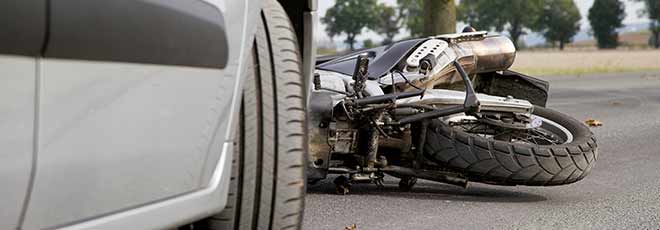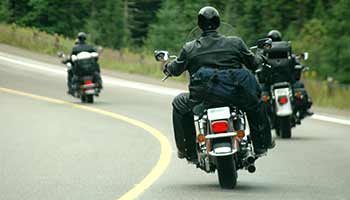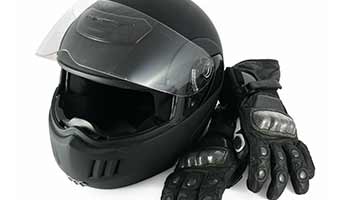
Research indicates that most motorcycle fatalities are attributed to head injuries. In a severe accident, a rider’s skull may be fractured and the brain may be seriously injured by penetrating objects and bone fragments. To protect yourself against head injuries while riding, the law offices of d’Oliveira & Associates would like to kindly remind the riders of New England to always wear a helmet.
 With warmer weather on the way, motorcyclists are getting ready to take to the roadways. Before getting back on the bike however, motorcyclists should be mindful of safety guidelines, and most importantly, making sure they have an appropriate helmet to wear for each ride. A helmet is the most important protective gear riders can wear while operating their motorcycle. Helmets are not a “cure-all” for motorcycle safety, but in the event of an accident, a helmet can be the most crucial piece of safety equipment insofar as protecting from head trauma, and saving your life.
With warmer weather on the way, motorcyclists are getting ready to take to the roadways. Before getting back on the bike however, motorcyclists should be mindful of safety guidelines, and most importantly, making sure they have an appropriate helmet to wear for each ride. A helmet is the most important protective gear riders can wear while operating their motorcycle. Helmets are not a “cure-all” for motorcycle safety, but in the event of an accident, a helmet can be the most crucial piece of safety equipment insofar as protecting from head trauma, and saving your life.
 Wearing a helmet indicates to others on the road that you are a responsible motorcyclist, who takes motorcycling and its accompanying safety risks seriously. In terms of the basic requirements for a helmet, many states require a specific amount of reflective material on the helmet. Your local Department of Motor Vehicles can provide you with exact information on the location and number of square inches of reflective material required to meet the state’s applicable regulations.
Wearing a helmet indicates to others on the road that you are a responsible motorcyclist, who takes motorcycling and its accompanying safety risks seriously. In terms of the basic requirements for a helmet, many states require a specific amount of reflective material on the helmet. Your local Department of Motor Vehicles can provide you with exact information on the location and number of square inches of reflective material required to meet the state’s applicable regulations.
Riding Through New England? – Avoid a Ticket, Know the Law

- CT: In the State of Connecticut, no one under 18 years of age is permitted to operate or ride on a motorcycle without a helmet.
- ME: In Maine, all motorcycle and side car passengers under the age of 18 are required to wear a helmet. Furthermore, operators who have been licensed for one year or less since their driver’s test (as well as operators driving with only a learner’s permit) must wear a helmet. Lastly, when the operator is required to wear a helmet, any passengers must also wear a helmet.
- MA: Massachusetts requires all motorcycle drivers and riders to wear a helmet that meets the Registrar of Motor Vehicle’s minimum standards. The state’s mandatory helmet law also applies to any sidecar passengers. Motorcycle operators must also wear either eyeglasses, goggles, or some sort of protective face shield if their bike is not equipped with a windshield or screen.
- NH: New Hampshire requires all riders under the age of 18 to wear helmets.
- RI: In Rhode Island, anyone under the age of 21 operating a motorcycle must also wear a helmet. All new operators, regardless of their age, must wear a helmet for a period of one year following the date that their motorcycle license was issued. All operators, regardless of age, must also wear eye protection. As a motorcycle passenger, you must also wear a helmet. Motorcycle helmets and eye protection must be approved by the RI Department of Motor Vehicles.
- VT: In Vermont, motorcycle operators and passengers alike must wear a helmet with reflective elements at least in part, and of a type approved by the Department of Motor Vehicles Commissioner. All helmets must also have a neck or chin strap feature.
Finding the Best Motorcycle Helmet for You
When looking around for a good helmet that you will want to wear and enjoy wearing while riding, bear in mind the 4 S’s – that is, size, strap, straight, and sticker:
 Wearing the proper size helmet is important for visibility and protection. If a rider wears a helmet that is too large, the helmet may move around and interfere with a rider’s vision, sliding down over the eyes. On the contrary, if the helmet is too small, it may still move around, but the real concern is the helmet failing to provide protection in the places your head needs it most. In terms of finding a helmet that will be the proper size and give you an appropriate fit, try on several different helmets before making any purchase of one.
Wearing the proper size helmet is important for visibility and protection. If a rider wears a helmet that is too large, the helmet may move around and interfere with a rider’s vision, sliding down over the eyes. On the contrary, if the helmet is too small, it may still move around, but the real concern is the helmet failing to provide protection in the places your head needs it most. In terms of finding a helmet that will be the proper size and give you an appropriate fit, try on several different helmets before making any purchase of one.
Comparing different helmets in relation to one another will be the best way to gauge comfort level and fit. A helmet of the correct size should fit comfortably all the way around your head. When trying a helmet on, try to insert your fingers around the edge of the helmet. If there is too much room on either side or in the front or back, the helmet it too big and you may need a smaller one. If it feels a bit large and a smaller helmet does not work, additional pads may work in the larger helmet to improve the fit and make it more snugly.
The chin strap is an important feature on every helmet, and it should fit around your ear and under your chin in a snug, comfortable manner. The helmet should not shift in any direction on your head. When wearing a helmet, riders should make sure that the straps are neither twisted nor tangled. The side straps should go both in front and behind the ear, with the side buckles directly underneath the ear lobes. Straps should be adjusted one at a time so the fit becomes gradually more tight or loose. The straps should buckle comfortably under your chin, allowing you to open your mouth, but not pulling the helmet down your head. If you can shift the helmet off of your forehead or if it moves when you shake your head, the helmet may be too big, or the straps may be too loose. If the straps are not fastened correctly ensuring proper position of the helmet, your helmet may not be there when you need it most.
 The helmet should be worn straight on your head, with the front hitting just above your eyebrows. Riders should be able to distinguish the front and back of the helmet and make sure to never wear their helmet backwards. The helmet should be straight and level in the front, worn low on the forehead just above the eyebrows.
The helmet should be worn straight on your head, with the front hitting just above your eyebrows. Riders should be able to distinguish the front and back of the helmet and make sure to never wear their helmet backwards. The helmet should be straight and level in the front, worn low on the forehead just above the eyebrows.
As the final consideration when buying a helmet, riders should look for stickers designating compliance with the Consumer Products Safety Commission (CPSC) and/or the American Society of Testing Materials (ASTM) and/or the American National Standards Institute (ANSI). Any helmet should have a sticker stating the helmet meets the CPSC helmet standard, which is mandatory in the United States. Additional stickers may indicate further compliance with more stringent standards; in sum – the safer, the better.
 Although riders may heed all the proper precautions while riding and wear appropriate safety equipment, accidents can still happen. If you or a loved one has been injured in a motorcycle accident, you may be entitled to compensation. The attorneys and legal staff at d’Oliveira & Associates have experience handling motorcycle accident cases and charge no fees unless you obtain a settlement or award. Give us a call or fill out a contact form for a free, no obligation evaluation of your motorcycle case.
Although riders may heed all the proper precautions while riding and wear appropriate safety equipment, accidents can still happen. If you or a loved one has been injured in a motorcycle accident, you may be entitled to compensation. The attorneys and legal staff at d’Oliveira & Associates have experience handling motorcycle accident cases and charge no fees unless you obtain a settlement or award. Give us a call or fill out a contact form for a free, no obligation evaluation of your motorcycle case.


